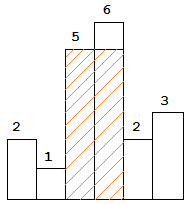被虐了……这个题目其实不难,但是从一开始想法有个漏洞没有发现…一直没有转过弯来…还是需要训练训练…
原题链接:Random Pancake Stack
Charlie has N pancakes. He wants to serve some of them for breakfast. We will number the pancakes 0 through N-1. For each i, pancake i has width i+1 and deliciousness d[i].
Charlie chooses the pancakes he is going to serve using the following randomized process: He starts by choosing the first pancake uniformly at random from all the pancakes he has. He places the chosen pancake onto a plate. This pancake now forms the bottom of a future stack of pancakes. Then, Charlie repeats the following procedure:
- If there are no more pancakes remaining, terminate.
- Choose a pancake uniformly at random from the pancakes that have not been chosen yet.
- If the width of this pancake is greater than the width of the pancake on top of the stack, terminate without taking it.
- Place the chosen pancake on top of the stack and go back to step 1.
You are given the vector d with N elements. The total deliciousness of a serving of pancakes is the sum of the deliciousness of all pancakes used in the serving. Compute and return the expected value of the total deliciousness of the pancakes chosen by Charlie.
继续阅读:→



